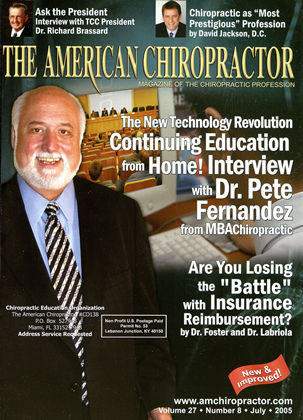I think our colleges are still quite different in their educational philosophy as it relates to the teaching of chiropractic medicine as a clinical practice. Some schools still adhere to the old dogma—which is to say the "above down, inside out" theory of chiropractic practice, while others are teaching modern, science-based natural medicine. I suppose, in some ways, this is good, as it provides a choice for prospective students; however, at the same time, it functions as a true barrier to professional unity. Frankly, I believe chiropractic doctors should all be physicians who practice natural medicine with emphasis on spinal manipulation as a primary modality of care, and surround that emphasis with good strong application of current knowledge of therapeutic nutrition, therapeutic exercise, rehabilitation, physiological therapeutics, nutri-ceuticals, and botanicals. The use of acupuncture, where permitted, should be strongly considered. I also believe our practicing doctors lack cultural/clinical authority and the time is here that we, in seeking the remedy to those concerns, should be looking carefully at the value of limited prescriptive rights for chiropractic physicians who wish to expand their education somewhat (some graduates have considerable pharmacology education and some have little or none). This concept was thoroughly vetted by Dr. William Dallas when he was president of Western States Chiropractic College, but he was a little too far ahead of his time. Now, we are behind the curve and the percentage of citizens who utilize chiropractic services is currently down to 7% of the population instead of the 10% of a few years ago. I see us backing into a smaller and smaller box titled "manipulators of people with low back pain." Some will think that is ok; but that box has been suddenly filled with people called physical therapists, who are 115,000 strong and have changed their minds about manipulation being quackery. It is no secret that insurance companies are restricting chiropractic physicians more and more. The only way to remedy this situation is to expand scope of practice. I think our practice emphasis should not change—natural medicine with emphasis upon spinal manipulation as a primary modal- i ity of care, etc.—however, we ' need the cultural and clinical authority that goes with the right to prescribe and, incidentally, to recommend that patients cease taking certain drugs. Until we gain that right, we will remain secondary citizens in the health care arena. I also believe that we are missing the boat at some institutions by not mandating education of students as future primary care physicians. Some, in my opinion, are teaching to insurance reimbursement experience, rather than to the needs and values of potential patients. The successful practitioner of the future will have true cultural authority, a strong education in the basic and clinical sciences, a rigorous understanding of "best practices," and soon, I hope, residency based experience prior to actual practice. To this end, National has recently instituted Master of Science degrees in Advanced Practice and in Radiology. These kinds of credentials cannot be overlooked and will expand the cultural authority to which I refer above. Chiropractic education in some places is better than ever, but it is not enough and we must, in my opinion, continue to scrutinize the future with eyes wide open and minds not tainted by the dogma of the past, or we will find ourselves shrinking rather than growing. Jim Winterstein, D. C. President, National University of Health Sciences.
 View Full Issue
View Full Issue






